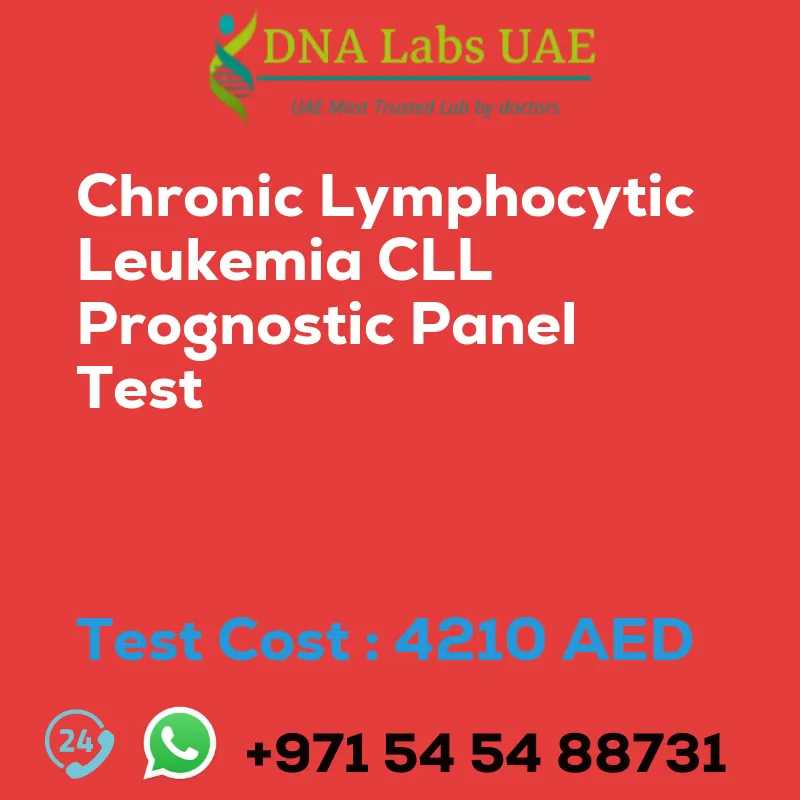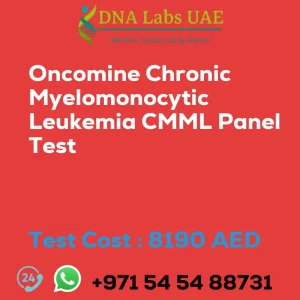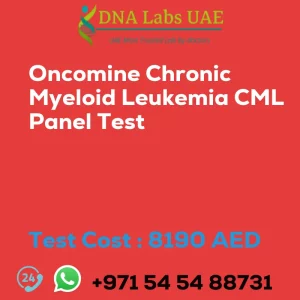CHRONIC LYMPHOCYTIC LEUKEMIA (CLL) PROGNOSTIC PANEL Test
Test Cost: AED 4210.0
Symptoms, Diagnosis, and Test Details
Chronic Lymphocytic Leukemia (CLL) is a type of cancer that affects the lymphocytes, a type of white blood cell. To determine the prognosis of patients with CLL, DNA Labs UAE offers the CLL Prognostic Panel Test. This diagnostic test analyzes specific genetic and molecular markers in the patient’s leukemia cells to predict the likelihood of disease progression and overall survival.
The CLL Prognostic Panel Test includes various markers:
- Immunoglobulin heavy chain variable region (IGHV) mutation status: This marker helps determine the aggressiveness of the disease. Patients with unmutated IGHV have a poorer prognosis compared to those with mutated IGHV.
- Zeta-chain-associated protein kinase 70 (ZAP-70) expression: ZAP-70 is a protein that is often overexpressed in aggressive forms of CLL. High levels of ZAP-70 indicate a higher risk of disease progression and poorer outcomes.
- CD38 expression: CD38 is a protein found on the surface of CLL cells. Higher levels of CD38 expression are associated with more aggressive disease and a poorer prognosis.
- FISH (fluorescence in situ hybridization) analysis: FISH testing detects specific genetic abnormalities in CLL cells, such as deletions or rearrangements of certain chromosomes. These abnormalities can provide additional information about the patient’s prognosis and guide treatment decisions.
The CLL Prognostic Panel Test helps doctors classify patients into different risk groups, such as low-risk, intermediate-risk, or high-risk, based on the likelihood of disease progression and overall survival. This information is valuable for determining the most appropriate treatment approach, including whether to initiate treatment immediately or adopt a watch-and-wait strategy.
It’s important to note that the CLL Prognostic Panel Test is just one tool among many used to assess CLL prognosis. Other factors, such as the patient’s age, overall health, and response to treatment, also play a role in determining the prognosis. Therefore, the test results should be interpreted in conjunction with other clinical and laboratory findings.
Test Components:
- ZAP 70
- CD38
- CD49d
- IGVH
- del11q23(ATM)
- del17p13.1(TP53)
- del13q14.3
- del13q34
- Trisomy 12
Test Information:
- Price: AED 4210.0
- Sample Condition: 4 mL (2 mL min.) whole blood from 1 Lavender top (EDTA) tube AND 5 mL (3 mL min.) whole blood OR 4 mL ( 2 mL min.) Bone Marrow from 2 Green Top (Sodium Heparin) tubes. Ship at 18-22°C. DO NOT FREEZE.
- Report Delivery: Sample Mon by 9 am; Report Next Mon
- Method: PCR Sequencing, FISH, Flow cytometry
- Test Type: Leukemia
- Doctor: Hematologist, Oncologist
- Test Department: MOLECULAR DIAGNOSTICS
- Pre Test Information: Duly filled Chromosome & FISH analysis Requisition Form (Form 17) is mandatory.
| Test Name | CHRONIC LYMPHOCYTIC LEUKEMIA CLL?ÿ PROGNOSTIC PANEL Test |
|---|---|
| Components | *ZAP 70*CD38*CD49d*IGVH *del11q23(ATM)*del17p13.1(TP53) *del13q14.3*del13q34*Trisomy 12 |
| Price | 4210.0 AED |
| Sample Condition | 4 mL (2 mL min.) whole blood from 1 Lavender top (EDTA) tube AND 5 mL (3 mL min.) whole blood OR 4 mL ( 2 mL min.) Bone Marrow from 2 Green Top (Sodium Heparin) tubes. Ship at 18-22?\u00f8C. DO NOT FREEZE. Duly filled Chromosome & FISH analysis Requisition Form (Form 17) is mandatory. |
| Report Delivery | SampleMon by 9 am; Report Next Mon |
| Method | PCR Sequencing, FISH, Flow cytometry |
| Test type | Leukemia |
| Doctor | Hematologist, Oncologist |
| Test Department: | MOLECULAR DIAGNOSTICS |
| Pre Test Information | Duly filled Chromosome & FISH analysis Requisition Form (Form 17) is mandatory. |
| Test Details |
The CLL prognostic panel test is a diagnostic test used to determine the prognosis of patients with chronic lymphocytic leukemia (CLL). CLL is a type of cancer that affects the lymphocytes, a type of white blood cell. The prognostic panel test analyzes specific genetic and molecular markers in the patient’s leukemia cells to predict the likelihood of disease progression and overall survival. It helps doctors tailor the treatment plan based on the patient’s individual risk profile. The test typically includes various markers, such as: 1. Immunoglobulin heavy chain variable region (IGHV) mutation status: This marker helps determine the aggressiveness of the disease. Patients with unmutated IGHV have a poorer prognosis compared to those with mutated IGHV. 2. Zeta-chain-associated protein kinase 70 (ZAP-70) expression: ZAP-70 is a protein that is often overexpressed in aggressive forms of CLL. High levels of ZAP-70 indicate a higher risk of disease progression and poorer outcomes. 3. CD38 expression: CD38 is a protein found on the surface of CLL cells. Higher levels of CD38 expression are associated with more aggressive disease and a poorer prognosis. 4. FISH (fluorescence in situ hybridization) analysis: FISH testing detects specific genetic abnormalities in CLL cells, such as deletions or rearrangements of certain chromosomes. These abnormalities can provide additional information about the patient’s prognosis and guide treatment decisions. The results of the CLL prognostic panel test help doctors classify patients into different risk groups, such as low-risk, intermediate-risk, or high-risk, based on the likelihood of disease progression and overall survival. This information is valuable for determining the most appropriate treatment approach, including whether to initiate treatment immediately or adopt a watch-and-wait strategy. It’s important to note that the CLL prognostic panel test is just one tool among many used to assess CLL prognosis. Other factors, such as the patient’s age, overall health, and response to treatment, also play a role in determining the prognosis. Therefore, the test results should be interpreted in conjunction with other clinical and laboratory findings. |








